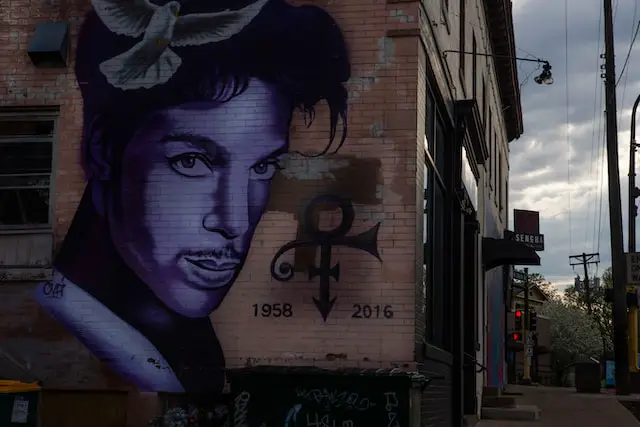[Image Credit: Photo by Javier Quiroga from Unsplash]
Prince Rogers Nelson (June 7, 1958 – April 21, 2016) an American sensation who transcended genres and captivated hearts worldwide. Prince, a multifaceted artist, was renowned for his eclectic music, flamboyant stage charisma, avant-garde fashion, and expansive vocal prowess. A true music legend, he earned his place in the Rock and Roll Hall of Fame in 2004.
Born and bred in Minneapolis, Minnesota, Prince’s musical odyssey began at a tender age, composing his first tune at 7 years old. His ascent to stardom was meteoric; he signed a recording deal with Warner Bros.
Records at 17 and dropped his debut album, ‘For You,’ in 1978. Over his illustrious career, Prince delivered over 40 albums, including iconic works like ‘1999,’ ‘Purple Rain,’ ‘Sign o’ the Times,’ and ‘Musicology.’
His accomplishments included 7 Grammy Awards, a Golden Globe, and an Academy Award for ‘Purple Rain.’ Yet, Prince remained an enigmatic figure, celebrated for his groundbreaking artistry and enigmatic persona.
Tragically, he passed away at his Paisley Park studio in Chanhassen, Minnesota, at the age of 57, leaving behind an enduring legacy.
| Real Name | Prince Rogers Nelson |
| Date of Birth | June 7, 1958 |
| Age at Death | 57 years old |
| Place of Birth | Minneapolis, Minnesota, U.S. |
| Parents | John L. Nelson, Mattie Della Shaw |
| Siblings | Tyka Nelson, Sharon Nelson, Norrine Nelson, John R. Nelson, Duane Nelson |
| Spouses | Mayte Garcia (m. 1996–2000), Manuela Testolini (m. 2001–2006) |
| Children | Boy Gregory (1996–2020) |
| Education | Central High School in Minneapolis |
| Music Genres | Funk, R&B, pop, rock, soul |
| Debut Album | For You (1978) |
| Notable Albums | 1999, Purple Rain, Sign o’ the Times |
| Height | 5 ft 2 in |
| Net Worth | $300 million (estimated) |
How was Prince an Icon?
Prince, born Prince Rogers Nelson, was the epitome of musical versatility. He possessed
unparalleled talent, not only as a singer but also as a songwriter, instrumentalist, and producer.
His prowess extended across multiple instruments, with his guitar solos becoming legendary. His iconic fashion sense, flamboyant stage presence, and gender-fluid style challenged societal norms and redefined masculinity in music.
His influence on pop culture and the music industry was profound, transcending boundaries of race, gender, and genre.
Family Life of Prince
Prince’s journey began in a musically inclined family. Raised in Minneapolis, Minnesota, he was born to Mattie Della and John Lewis Nelson.
His father excelled as both a pianist and songwriter, while his mother showcased her talents as a jazz singer. This familial background provided Prince with a rich musical tapestry from an early age.
The backdrop of his upbringing and the encouragement he received from his parents played a pivotal role in shaping his musical destiny. The Nelson family provided a nurturing environment necessary for the Prince to develop his extraordinary talents.
Manuela’s Influence
Manuela Testolini played a pivotal role in Prince’s personal life. She was Prince’s second wife, and their marriage was a significant chapter in his life.
Beyond their relationship, Testolini and Prince collaborated on philanthropic efforts, particularly through the charity organization “In a Perfect World.”
Her influence and support contributed to the preservation of Prince’s legacy, and the bio of Manuela Testolini underscores the depth of their connection.
The Symbol Formerly Known as Prince
In the 1990s, Prince’s career took a unique turn when he adopted an unpronounceable symbol as his name. This move was not only emblematic of his artistic rebellion but also a strategic one.
It was a protest against the restrictive contracts with Warner Bros. Records. The symbol, often referred to as the “Love Symbol,” became an enigmatic representation of the artist himself. It was a clever play on the notion that he was “the artist formerly known as Prince.” This change stirred intrigue and controversy, yet it symbolized his independence and artistic freedom.
Why was Prince called the artist formerly known as Prince?
Prince’s decision to adopt the symbol was a bold act of defiance. It allowed him to distance himself from his record label and regain control of his music. The symbol was a protest against the corporate constraints that had limited his creative expression.
After years of legal battles and artistic struggles, Prince eventually reclaimed his birth name. His triumphant return to “Prince” marked a significant moment in his career, symbolizing not only his legal victory but also his unwavering commitment to his artistry.
Why is Prince Important to Music?
Prince’s importance in the world of music cannot be overstated. He was a genre-bending
pioneer, blending funk, rock, pop, and R&B into a unique sonic tapestry. His albums, such as “Purple Rain” and “Sign o’ the Times” remain iconic and groundbreaking.
Prince’s music was more than just melodies and lyrics; it was a cultural force, according to the Schomburg Center for Research in Black Culture. His songs often addressed social issues and championed artists’ rights, making him a prominent advocate for musicians’ creative autonomy.
